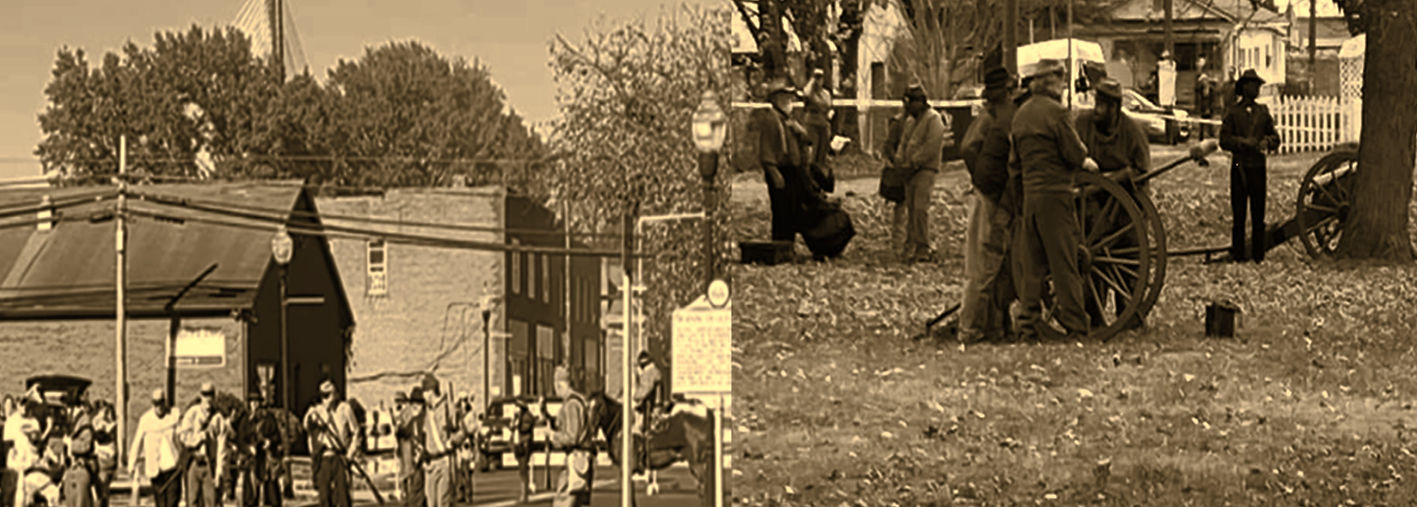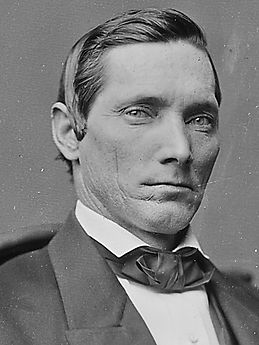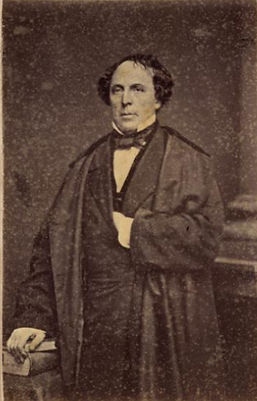
Just What Happened In Guyandotte
November 1861?

Colonel Kellian V Whaley
In the early throes of the War Between the States in 1861, Cabell and Wayne Counties bore witness to profound divisions, as brethren flocked beneath divergent banners. Guyandotte, a modest haven nestled by the Ohio River, stood resolute as the solitary voice advocating for secession from the Union. In April of that year, the gallant denizens of Guyandotte proudly unfurled the Virginia state flag, delivered fervent speeches, and rallied into volunteer companies for the Confederate cause. Among them, the Border Rangers, under the sagacious command of Albert Gallatin Jenkins, marshaled their ranks. Meanwhile, a stone's throw downriver, the Unionist bastion of Ceredo heralded the birth of the Fifth (West) Virginia Volunteer Infantry Regiment in unwavering opposition.
With the departure of Confederate recruits to the Kanawha Valley, Guyandotte found itself exposed, susceptible to the Union's advance. July witnessed the fleeting occupation of the town by the Second Kentucky Infantry, compelling local loyalty to the Union through solemn oaths.
Come October 1861, Colonel Kellian V. Whaley descended upon Guyandotte, establishing a recruitment citadel for the nascent Union regiment, the Ninth (West) Virginia Infantry. Approximately 150 valiant men enlisted, yet their training remained meager during their sojourn in Guyandotte. As November's chill set in, Confederate General John B. Floyd issued orders for a daring cavalry raid toward the Ohio River. A force, numbering perhaps 700, hailing from the Fifth and Eighth Virginia Cavalry Regiments, led by Colonels John Clarkson and Albert Gallatin Jenkins, descended upon Cabell County.
On the eve of November 10, 1861, the Confederate raiders descended upon Guyandotte with stealth, catching the unseasoned Union recruits unaware. Colonel Whaley sought to muster a defense, but the Confederate horsemen, swift as spirits, outpaced the resistance. A vital bridge succumbed in the west, and a Confederate contingent enveloped the eastern precincts of Guyandotte, encircling the Union forces. Gallant souls endeavored to brave the Guyandotte River, only to meet a storm of lead midstream. Despite Whaley's determined resistance, the Forest Hotel emerged as the last bastion before the inevitable surrender. The skirmish yielded approximately three Confederate casualties and ten wounded, while ten Union soldiers paid the ultimate price, and a similar number suffered wounds. A hundred Union troops, including the valiant Whaley, succumbed to captivity, while fewer than fifty managed to elude the grasp of the Confederate foe. Reports hinted at the audacious participation of Guyandotte denizens in the raid, with some accounts alleging gunfire upon Union troops from the sanctity of their homes.
As dawn painted the morning of November 11, Colonel John Zeigler and Union troops arrived belatedly from Ceredo, descending upon Guyandotte via the steamer Boston. Their arrival coincided with the departure of the last Confederate raiders and their captives, too late to alter the course of the battle. Fueled by ire at casualties and rumors of secessionist complicity, Zeigler's troops, in a swift and resolute move, set ablaze the town. Secessionist abodes and establishments bore the brunt, yet even Unionist properties found themselves engulfed by the raging inferno. Much of Guyandotte succumbed to the relentless flames, including the Buffington Mill, Guyandotte Baptist Church, the bustling commercial district, and countless homesteads. The indomitable Madie Carroll House stood as one of the rare structures spared, as Mary Carroll's resolve forced the Union troops to march on.
In their departure, the Union forces detained sixteen residents deemed complicit in the raid, dispatching them to Camp Chase Prison in Columbus, Ohio. Ohio, playing a pivotal role in these events, supplied militia instrumental in the town's capture and burning. The Fifth West Virginia Infantry drew heavily from Ohio men, with Lawrence County contributing over 400 soldiers to the regiment, alongside 129 men for the Ninth West Virginia Infantry. Even the Second Kentucky Regiment, though credited to Kentucky, comprised mainly Ohioans. As the Wheeling Daily Intelligencer remarked on November 13, 1861, Guyandotte, notorious as the "orneriest" spot on the Ohio River, akin to a miniature Vicksburg, displayed the first secession flag on the river and stood as the most fervent secessionist nest in the region, deserving incineration years prior.
Written by:
Buck Buchannan

General John B. Floyd

Colonel Albert G. Jenkins

5th West Virginia Volunteer Infantry Regiment
The 5th West Virginia Infantry Regiment was organized at Ceredo, West Virginia, beginning on September 3, 1861, and mustered in on October 18, 1861. Originally mustered into service as the 5th Virginia Regiment of the Union Army, it became the 5th West Virginia when West Virginia was designated a distinct state. Organized in southwestern West Virginia, the majority of men were recruited from southern Ohio and eastern Kentucky, with many others from Wayne County, West Virginia.
Lawrence County, Ohio, alone provided 419 men to the regiment. Served Unattached, District of the Kanawha, West Virginia, to March, 1862. District of Cumberland, Md., Mountain Department, to April, 1862. Milroy's Independent Brigade, Mountain Department, to June, 1862. Milroy's Independent Brigade, 1st Army Corps, Army of Virginia, to September, 1862.
Under Milroy, the 5th Virginia (later to be designated the 5th West Virginia) fought at the Battle of McDowell, May 8, 1862 and the Battle of Cross Keys on June 8, 1862, with the regiment under the command of Col John L. Ziegler. Defenses of Washington, D.C., to October, 1862. District of the Kanawha, West Virginia, Dept. Ohio, to January, 1863. Unattached, District of the Kanawha, West Virginia, to March, 1863. 1st Brigade, 3rd Division, 8th Army Corps, Middle Department, to June, 1863. 1st Brigade, Scammon's Division, Dept. of West Virginia, to December, 1863. 1st Brigade, 3rd Division, West Virginia, to April, 1864. 1st Brigade, 2nd Infantry Division, West Virginia, to November, 1864.
The 9th Regiment, West Virginia Infantry organized at Guyandotte (Huntington), Cabell and Wayne Counties, November 28, 1861, to April 30, 1862. It consolidated with the 5th Regiment, West Virginia Infantry November 9, 1864, to form the 1st Regiment, West Virginia Veteran Infantry

8th Virginia Cavalry Regiment
The 8th Virginia Cavalry Regiment was a cavalry regiment raised in Virginia for service in the Confederate States Army during the American Civil War. It fought mostly as part of the Army of Northern Virginia.
Virginia's 8th Cavalry Regiment was organized early in 1862 with nine companies but increased its number to eleven to July. Many of the men were recruited in Cabell, Wayne, Mercer, Fayette, Greenbrier, Bland, Smyth, Nelson, Kanawha, and Tazewell counties.
The unit confronted the Union in western Virginia, fought in East Tennessee then returned to western Virginia. Later it participated in Early's Shenandoah Valley operations and the Appomattox Campaign.
Newspaper Reports at the Time
Richmond Daily Dispatch
November 25, 1861
The fight at Guyandotte.
The Lynchburg Republican, of the 23d inst., contains the following in regard to the taking possession of Guyandotte by the Confederates. We have published several accounts of the affair from Yankee sources, but do not recollect to have seen anything in regard to it from our own side:
On the 9th inst., Col. Clarkson, of the cavalry, from Gen. Floyd's Brigade, marched some two hundred miles to Guyandotte, and completely surprised the Yankee troops in the town, numbering two hundred and fifty, under the command of Col. Whaley, one of the traitor members of Congress, elected from Western Virginia. Col. Clarkson arrived at the village about 8 o'clock A. M., took possession of the bridge, and cut off all retreat.--The fight lasted about one hour, the Yankees fighting from the houses and places of concealment. He took ninety-eight prisoners, killed forty, wounded fifty, and caused many to be drowned who took to the river for escape.--Only some forty of the whole saved their bacon. We also captured two hundred and fifty Enfield rifles, $5,000 worth of clothing, thirty cavalry horses, and various other plunder, valued at $25,000. We lost two men killed and five wounded. The people of the town received our men with great cordiality, and gave them a fine supper. They remained until eight o'clock next morning, and returned to Gen. Floyd's camp with all their trophies of victory. The enemy soon after took possession of the town and burnt it. Both officers and men behaved well, and especially gallant was the conduct of Col. Clarkson, Lieutenant-Colonel Jenkins, Capt. Pate, and others. The Yankee Colonel was taken prisoner, and, being placed on his parole of honor, managed to make his escape on the march.
Gallipolis Journal
November 21, 1861
John Lawson and Thomas Berridge, two of the Guyandotte prisoners, arrived here Wednesday evening. They were released on the following Tuesday after their capture, about 35 miles from Guyandotte. The whole cavalry force was under command of John Clarkson, and numbered about fourteen hundred, of which only about 800 were concerned in the Guyandotte affair. Jenkins' plan was, to quietly surround the town, await the arrival of a steamboat at the landing, then make a rush and possess it, place the full rebel force on board, and make a descent upon Gallipolis. This, Clarkson would not adhere to, and immediately ordered a charge upon the handful of Federal troops that were garrisoning the place. About 100 prisoners were taken. The rebels occupied Guyandotte that night, and next morning he prisoners were tied together in pairs and put upon "double quick" from Guyandotte to Barboursville, a distance of six miles, with orders from the commander to shoot down all who lagged. In the evening of the same day they came up with the remainder of their forces, numbering some six hundred cavalrymen, well-armed, but poorly fed and clothed. From Sunday night until Tuesday morning, the rebels had nothing to eat but raw turnips and cabbage, and for variety they killed a beef, and literally ate it raw. They are represented as a set of desperate wretches upon whom the gallows would confer honor. Jim. Hereford was not among them. Bob. Stribling was Assistant Surgeon, and it was mainly through him that Lawson and Berridge were released.
Gallipolis Journal
November 14, 1861
Guyandotte Taken By Jenkins' Cavalry.
130 Union Men Taken Prisoner.
Citizens Of Guyandotte Fire Upon The Federal Troops.
The Town Laid In Ashes.
Sunday evening about half-past seven o'clock, nine hundred Secession Cavalry under A. G. Jenkins, made a descent upon the town of Guyandotte, garrisoned by one hundred Federal Infantry of the 9th Virginia Regiment, and 30 Cavalry belonging to the 5th Virginia. Most of the troops at the time of the attack were at church, or scattered about town, least suspecting an enemy, thus giving the rebels every advantage, but notwithstanding the disparity of numbers, the brave little band rushed to their arms and contested the ground against this formidable force for the space of one hour, when they were compelled to yield to superior numbers.
The rebels divided their forces at Barboursville, and coming down each side of Guyandotte river united, those on the lower side crossing the railroad bridge near the town.
A. G. Jenkins commanded the rebels in person, and their cry as they entered the town was - "take no prisoner" - give no quarter." Jim Hereford seemed to be the most conspicuous cut-throat among them, insisting that all should be killed.
Capt. Hunter and two privates ran for the Guyandotte river, pursued by a number of rebels. The privates plunged into the water and were shot in the middle of the stream while swimming for the opposite shore; the captain laid down at the edge of the water, and after the miscreants left, quietly slipped into the water, swam over and made his way to Ceredo.
From the best information, only seven of the Federalists were killed, and it is supposed the rebel loss was equally as great. They carried off all their killed and wounded except one captain, who was found in an alley shot through the heart.
A keel boat loaded with wheat, belonging to Wm. H. Langley was lying at the wharf. It was in charge of Mr. John Lawson, a miller in the employ of Mr. Langley, and three hands from this place - Thomas Berridge, Andrew Langley and John Blagg. Lawson and Berridge were at church when the attack was made, and the latter were on board the boat. Several Union citizens, together with Mr. Berridge, took refuge on this boat and had shoved her in the stream, when a large force of rebels made their appearance on the bank and opened an indiscriminate fire upon them, threatening at the same time to kill every man on board if they didn't land. At this juncture young Langley and Blagg jumped into a skiff attached to the boat and rowed for the Ohio side amidst a shower of bullets. The firing became so hot that they felt the greater safety was in jumping in the river and towing the boat, which they did amid a continuous shower of bullets until they reached the Ohio shore. Just as they landed a bullet struck the bank within a few inches of Mr. Blagg. The keel boat was landed and all on board taken prisoners.
The steamer Liberty, bound for Cincinnati, was hailed above Guyandotte by loyal citizens and turned back. She brought the news to this place, and about 600 of the 4th Virginia regiment, stationed at Pt. Pleasant, under command of Col. Lightburn, together with the Gallipolis Artil[l]ery, Capt. McClurg, proceeded immediately by steamboat to the scene of action. When they reached there a large force from Ceredo and points below had already assembled, and the rebels anticipating a warm time, scampered to the hills with about one hundred and thirty prisoners, among whom are Lt. Col. Bailey of the 9th Virginia Regiment, Dr. Jonathan Morris, formerly of this place, John Lawson and Thomas Berridge, in the employ of Wm. H. Langley, and all the Union men the scoundrels could lay hands on.
Col. Zeigler of the 5th Virginia Regiment, ascertaining that a trap had been laid by the Secesh citizens of Guyandotte to ensnare the Federal troops, and that they had actually fired upon the troops from their dwellings, ordered the match to be applied, and every house, except two in a remote part of the town, was laid in ashes.

